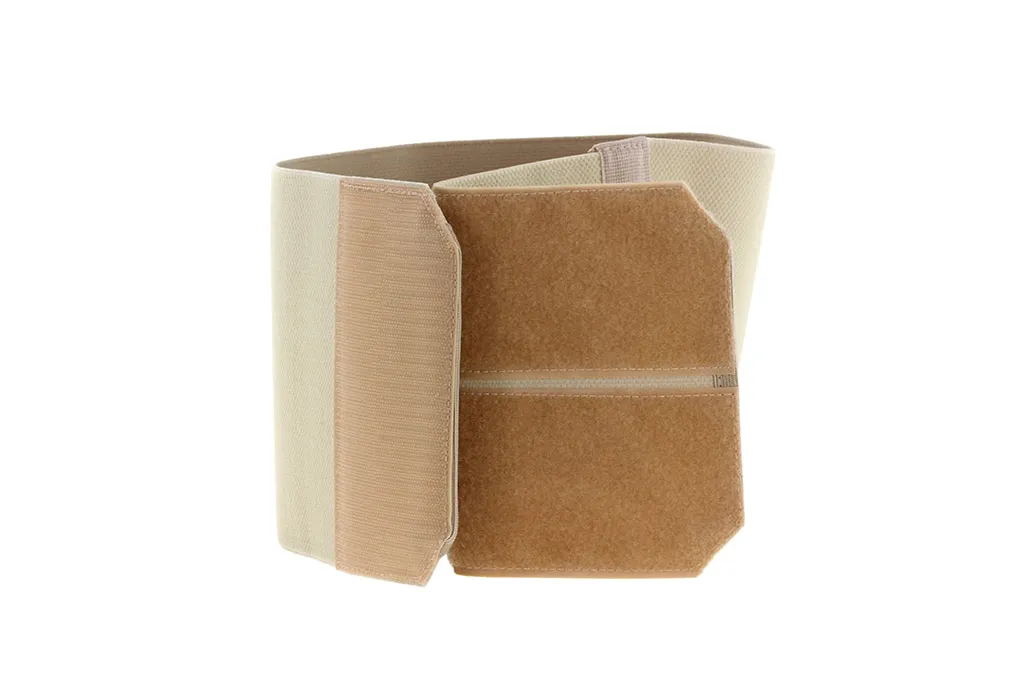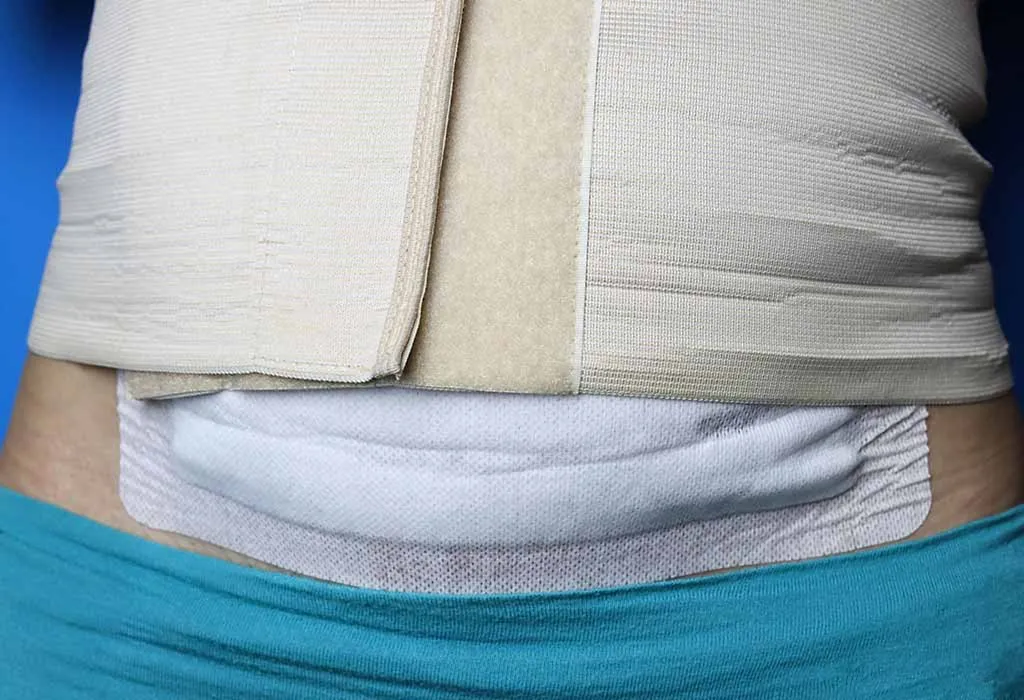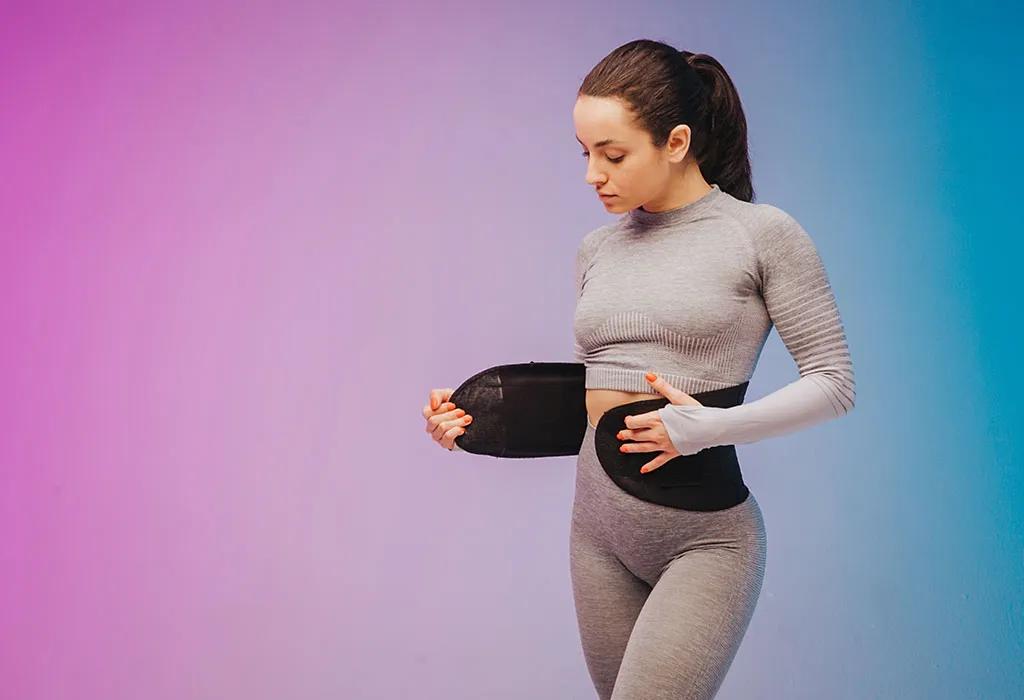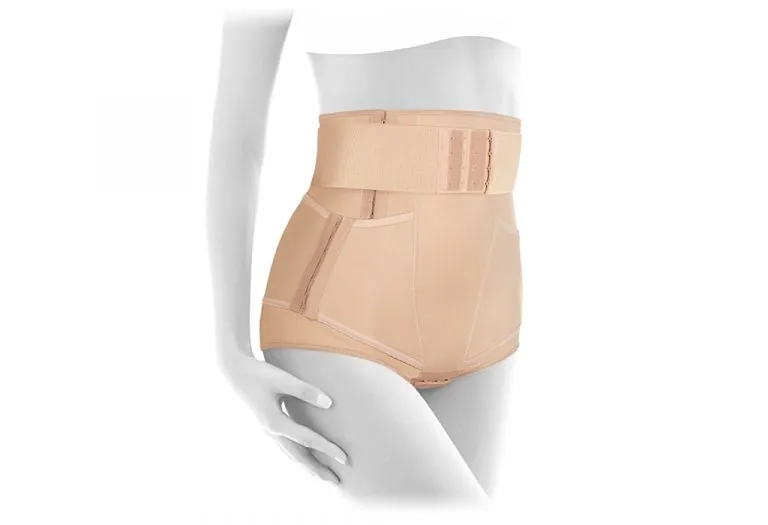Postpartum Waist Trainers: Types, Benefits, Risks & Safety Tips
- What Is Waist Training?
- Different Type of Postnatal Waist Trainer
- Benefits of Using Waist Trainers After Pregnancy
- Side Effects of Post-Pregnancy Waist Trainers
- Precautions to Take While Using Postnatal Weight Trainers
- Some Alternatives for Waist Trainers
- FAQs
It’s not uncommon to see celebrity moms and many other people back in perfect shape within months of giving birth. So, what’s the secret? Using postpartum waist trainers is believed to do the magic here! In today’s world, where many aim for the “perfect” body, this age-old method of waist training has become a popular way to help slim down the postpartum belly. These trainers can offer benefits like better posture, core support, and a boost in confidence. However, it’s important to use them carefully to avoid any health risks. In this article, we’ll look at the benefits of using a waist trainer after giving birth and the precautions new moms should keep in mind.
What Is Waist Training?
Waist training is an old method of tightly binding or wrapping the body’s midsection from the bottom of your ribs to the lower waist with a supportive band or a corset to gradually decrease the natural waistline. The process is thought to reshape the waist leading to slimming in women looking for a perfectly shaped waist. There are also claims that waist trainers promote heat in the abdomen, which causes perspiration and fat loss (1).
After birth, the changes in hormones and fluid content in the body can cause water retention in the abdomen. The accumulated water takes about two weeks to dissipate and two more weeks for the rest to subside. Meanwhile, it can take up to six weeks for the uterus to shrink from the size of a watermelon to its normal size (2). All this occurs naturally along with belly shrinkage whether women wear waist trainers or not. However, waist training is thought to speed up the process and help women shrink their bellies sooner.
The rationale behind waist training after delivery is that during pregnancy, the body releases a hormone called relaxin that softens the ligaments and cartilage. It helps during the final weeks of pregnancy to allow for increased flexibility to help with the baby’s passage through the birth canal. Wearing belly support such as a wrap or a band helps to stabilise the pelvis and keep it steadily in shape so that it stops shifting and heals. The advantage of this is that women can resume exercise sooner to return to their normal function and pre-pregnancy shape.

Different Type of Postnatal Waist Trainer
Post-baby waist trainers come in many designs, and they are made of different types of materials, such as spandex, and latex, with cotton, nylon and lycra added to the fabric. Here are some of the types:
1. Belly Wraps
Belly wraps are the simplest of the waist trainers and are usually a wide adjustable elastic band that wraps around your abdomen from below the ribs to the top of the waist. They provide gentle compression, which can often be adjusted with a Velcro tightener, and several designs are available for pregnant women. These are not as intense as corsets or waist trainers but offer excellent support right after birth for the first week or two until you’re ready to upgrade.
2. Abdominal Compression Binder
Abdominal compression binders are commonly used after surgery to stabilise the abdomen. They feature no-frills bands with adjustable compression that generally work with Velcro. Although it’s a general medical device not specific to postpartum mothers, it can be used as a support for the abdomen as part of waist training. A study conducted in 2019 found that women who wore abdominal binders after their c-sections were able to cover longer distances and had less feeling of distress than those who did not wear binders after 48 hours of operation. Since the incisions of c-sections stay fresh after such a short time, you should wait for 2-4 weeks and consult your doctor before using belly bands or wraps.
3. Waist Trainers/Cinchers
Waist trainers are tighter and designed to apply more pressure on the abdomen using zippers or hook-and-eye closures. These are the ones commonly seen by celebrities, and they can be worn under a regular dress or when you’re at home working. They cover the midsection of your body from under the breasts to the top of the hips. Cinchers are often made of latex-like stiff materials reinforced with plastic or metal boning. Their purpose is to apply extra firm compression and drastically reduce the waist size. They can be worn a month after giving birth anywhere from one to eight hours a day, depending on your comfort. They are believed to show results in about a month if worn for eight hours a day along with following a healthy diet. Cinchers can also be worn while working out.
4. Corsets
Corsets apply a much stronger compression than waist trainers or belly wraps. They contain steel bones in them, which are tightened using laces. Corsets are meant for body sculpting using high compression. They would feel uncomfortable in the beginning. Therefore, they should only be used in later stages when you’re ready to upgrade from all of the above. They can be worn for an hour or two a day until you get used to them, and then move to eight or twelve hours over the months.
Benefits of Using Waist Trainers After Pregnancy
Using a waist trainer after delivery has a number of benefits for postpartum women. Here are some:
1. Improves the Shape of Your Waist
Most new moms wish to lose their baby pouch as soon as possible. Wearing a waist trainer belt can help you lose all the fluid and fat fast to achieve a shapely waist. The waist training works by cinching the waistline to make the stomach take the shape of the waist trainer.
2. Improves Your Posture
Waist training corsets use materials such as plastics or metal bones that keep your back straight for as long as you wear them. Hence wearing these will enhance the posture of your back, keeping the spine straight and firm. If you tend to slouch or have back pain post-pregnancy, waist trainers can help improve your posture (3).

3. Eases Back Pain
Maintaining a good posture with the help of waist trainers can help you go a long way in fixing your upper and lower back pain problems. Maintaining a good posture while you sit and walk helps to take the stress off the back and reduce back pain. In a comprehensive study, it was found that belly bands can decrease distress and offer lower back support to those who had c-sections (4).
4. Makes You Eat Less
The waist trainer wrapped tightly around your abdomen won’t allow you to stuff yourself with food. As a consequence of less eating, you lose weight faster and get into shape sooner.
5. Soothes Menstrual Cramps
Some women find that cinchers help ease menstrual cramps. The pressure applied to the peritoneal organs can result in lesser contractions in the uterus and blocks during the period.
Side Effects of Post-Pregnancy Waist Trainers
Although post-pregnancy waist trainers are popular for helping new moms feel more supported and slim, they can also come with some unwanted side effects. Here are a few side effects that should be considered before using a postpartum belly wraps (1) (5).
- Some manufacturers use latex rubber as the band material, which can cause allergies in some women.
- Waist trainers that are too tight can cause breathing difficulties and lightheadedness.
- Tight waist trainers early during breastfeeding can make the mother eat less, which is bad for both her and the baby.
Precautions to Take While Using Postnatal Weight Trainers
While postpartum waist trainers can offer support and help new moms feel more confident, they should be used with care. Wearing them incorrectly or for too long can lead to discomfort or even health issues. Below is a list of important precautions every new mother should consider before using a postnatal waist trainer.
- If you plan to wear a waist trainer after a c-section, you must consider the area of the incision, which is still delicate. Start with simpler ones, such as belly wraps and abdominal compression binders, before moving to cinchers or corsets.
- Waist trainers should feel tight but not cause pain.
- Poor-quality trainers can cause more harm than good, so it’s better to buy a premium-quality waist trainer.
- Women with infections at the stitches or conditions, such as amnionitis or preeclampsia, should avoid them completely.

Some Alternatives for Waist Trainers
While waist trainers may work for some women, they aren’t the only option for postpartum recovery and support. There are several safer and more comfortable alternatives that can help new moms regain their strength and feel confident after childbirth. Here are a few options to consider:
1. Healthy Diet and Exercise
Eating a balanced diet and staying active are essential for getting back in shape after childbirth. It’s a good idea to talk to a doctor or fitness expert to create a plan that fits your body’s needs (6).
2. Core Strengthening Exercises
Doing exercises that focus on your core can naturally help tighten and tone your waistline without the risks that can come with waist trainers (7).
3. Postpartum Belly Bands
These bands gently support your belly and lower back after birth. They’re an easy alternative to waist trainers and can help your body heal comfortably.
4. Yoga and Pilates
Both yoga and Pilates are great for improving posture, flexibility, and core strength. They support your overall recovery while helping you feel more balanced and strong (8).
5. Waist-Targeted Workouts
Try workouts that combine cardio, strength training, and core exercises to help slim your waist in a healthy and lasting way.
FAQs
1. When should I start using post-pregnancy waist trainers?
The gentler trainers, such as belly wraps, can be used a few hours after you deliver, provided your doctor gives you an all-okay. Do confirm with your doctor before using it.
2. For how long should I wear a waist trainer?
Start with what feels comfortable; it could be one or two hours a day initially, and wear it for up to 8 or 12 hours. Most manufacturers recommend wearing it all day and night except when taking a bath for 30 to 60 days postpartum.
3. How can I choose the right size of waist trainer for me?
Measure the waistline five centimetres above your navel. Pick a waist trainer that is four inches smaller than your measured waistline. The hooks can be adjusted as your stomach shrinks.
4. Who should avoid using a postpartum waist trainer?
Women with high blood pressure, breathing problems, hernias, or recent C-sections (until fully healed) should avoid waist trainers unless their doctor approves it. Always consult a doctor before starting to use one.
5. What’s the difference between a waist trainer and a belly band?
A belly band offers gentle support and is designed for comfort and healing, while a waist trainer provides firmer compression and is more focused on shaping the waistline.
Waist trainers can help you shed that baby pouch and get back to your perfect figure in a short time. It’s essential that you also maintain a good diet and exercise routine to go with it for maximum benefits.
References/Resources:
2. The Health Care Authority of the City of Anniston – When Will “Pregnancy Belly” Go Away?
3. Cleveland Clinic – Postpartum Belly Wraps: Purpose, Types, Benefits & Risks
5. AMERICAN BOARD OF COSMETIC SURGERY – 4 Reasons to Throw Your Waist Trainer in the Trash
6. Cleveland Clinic – How To Lose Weight While Breastfeeding
7. Harvard Health Publishing – Waist trainers: What happens when you uncinch?
8. National Childbirth Trust – Postnatal exercise: how soon can I start again after a baby?
Also Read:
Exercises to Do After Delivery
Weight Loss Diet Plan after Delivery
Home Remedies to Reduce Belly Fat After Delivery
Was This Article Helpful?
Parenting is a huge responsibility, for you as a caregiver, but also for us as a parenting content platform. We understand that and take our responsibility of creating credible content seriously. FirstCry Parenting articles are written and published only after extensive research using factually sound references to deliver quality content that is accurate, validated by experts, and completely reliable. To understand how we go about creating content that is credible, read our editorial policy here.























